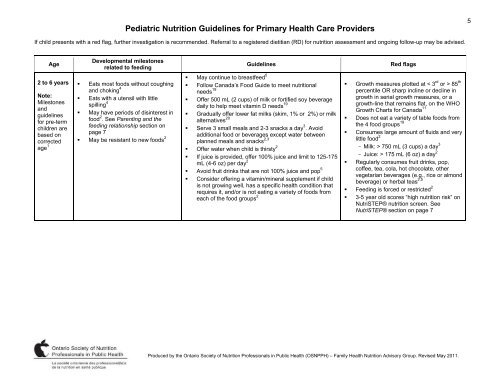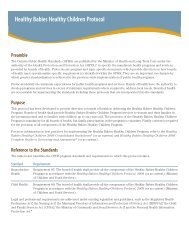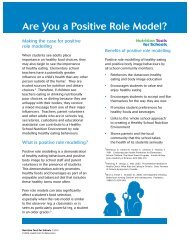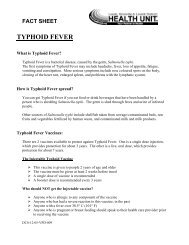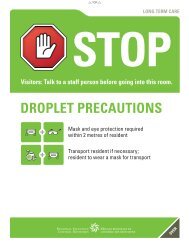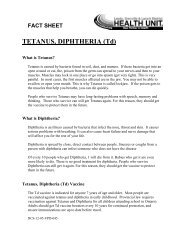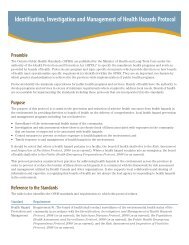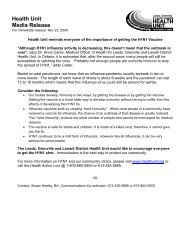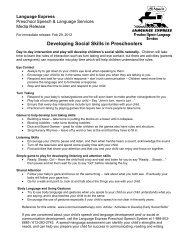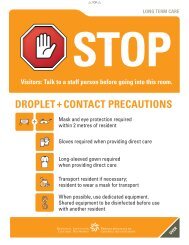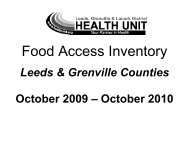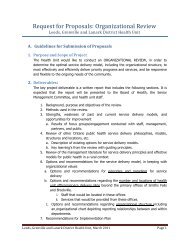Pediatric Nutrition Guidelines for Primary Health Care Providers
Pediatric Nutrition Guidelines for Primary Health Care Providers
Pediatric Nutrition Guidelines for Primary Health Care Providers
Create successful ePaper yourself
Turn your PDF publications into a flip-book with our unique Google optimized e-Paper software.
<strong>Pediatric</strong> <strong>Nutrition</strong> <strong>Guidelines</strong> <strong>for</strong> <strong>Primary</strong> <strong>Health</strong> <strong>Care</strong> <strong>Providers</strong><br />
5<br />
If child presents with a red flag, further investigation is recommended. Referral to a registered dietitian (RD) <strong>for</strong> nutrition assessment and ongoing follow-up may be advised.<br />
Age<br />
Developmental milestones<br />
related to feeding<br />
<strong>Guidelines</strong><br />
Red flags<br />
May continue to breastfeed 5<br />
2 to 6 years Eats most foods without coughing Follow Canada’s Food Guide to meet nutritional Growth measures plotted at < 3 rd or > 85 th<br />
and choking 4<br />
needs 19<br />
percentile OR sharp incline or decline in<br />
Note:<br />
Eats with a utensil with little<br />
Milestones<br />
Offer 500 mL (2 cups) of milk or <strong>for</strong>tified soy beverage<br />
growth in serial growth measures, or a<br />
spilling 4<br />
and<br />
daily to help meet vitamin D needs 19<br />
growth-line that remains flat, on the WHO<br />
guidelines<br />
May have periods of disinterest in<br />
Growth Charts <strong>for</strong> Canada 11<br />
Gradually offer lower fat milks (skim, 1% or 2%) or milk<br />
<strong>for</strong> pre-term<br />
food 2 . See Parenting and the<br />
alternatives 20<br />
Does not eat a variety of table foods from<br />
children are<br />
feeding relationship section on<br />
Serve 3 small meals and 2-3 snacks a day 3 the 4 food groups 19<br />
. Avoid<br />
based on<br />
page 7<br />
additional food or beverages except water between<br />
Consumes large amount of fluids and very<br />
corrected May be resistant to new foods 2 planned meals and snacks 2,3<br />
little food 2<br />
age 1 Offer water when child is thirsty 2<br />
- Milk: > 750 mL (3 cups) a day 3<br />
If juice is provided, offer 100% juice and limit to 125-175<br />
- Juice: > 175 mL (6 oz) a day 2<br />
mL (4-6 oz) per day 2<br />
Regularly consumes fruit drinks, pop,<br />
Avoid fruit drinks that are not 100% juice and pop 5<br />
coffee, tea, cola, hot chocolate, other<br />
vegetarian beverages (e.g., rice or almond<br />
Consider offering a vitamin/mineral supplement if child<br />
beverage) or herbal teas 2,5<br />
is not growing well, has a specific health condition that<br />
requires it, and/or is not eating a variety of foods from<br />
Feeding is <strong>for</strong>ced or restricted 2<br />
each of the food groups 2 3-5 year old scores “high nutrition risk” on<br />
NutriSTEP® nutrition screen. See<br />
NutriSTEP® section on page 7<br />
Produced by the Ontario Society of <strong>Nutrition</strong> Professionals in Public <strong>Health</strong> (OSNPPH) – Family <strong>Health</strong> <strong>Nutrition</strong> Advisory Group. Revised May 2011.


